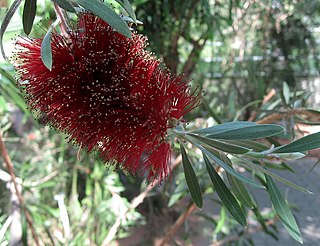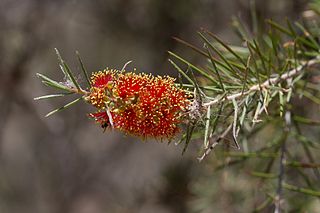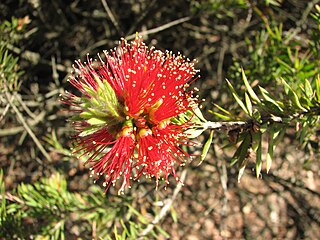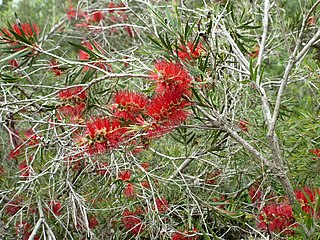
Melaleuca comboynensis, commonly known as cliff bottlebrush, is a plant in the myrtle family, Myrtaceae and is endemic to New South Wales and Queensland in Australia. It is usually a shrub, similar to Melaleuca citrina with its hard leaves, spikes of red flowers and clusters of cup-shaped fruits but differs in that its leaves are generally wider and its habitat is usually rocky outcrops rather than along watercourses.

Melaleuca pachyphylla, commonly known as wallum bottlebrush, is a plant in the myrtle family Myrtaceae, and is endemic to near-coastal regions of New South Wales and Queensland in Australia.. It is a medium-sized shrub with a straggling habit and red, or sometimes greenish, bottlebrush flowers in summer.

Melaleuca orophila, commonly known as needle bottlebrush or Flinders Ranges bottlebrush, is a plant in the myrtle family, Myrtaceae and is endemic to the eastern part of South Australia.. It is a medium-sized shrub with sharp-pointed, needle-like leaves and bright red bottlebrush flower spikes.

Melaleuca brachyandra, commonly known as prickly bottlebrush or scarlet bottlebrush, is a plant in the myrtle family, Myrtaceae and is endemic to New South Wales, Victoria and South Australia in Australia. It is a shrub or small tree with narrow leaves and showy red and green flowers making it an ideal ornamental plant in temperate areas.

Melaleuca recurva, commonly known as Tinaroo bottlebrush, is a plant in the myrtle family, Myrtaceae and is endemic to higher areas of far northern Queensland in Australia.. It is a shrub with spikes of red flowers tipped with yellow in most months of the year and which often has leaves with their edges curled under.

Melaleuca faucicola commonly known as desert bottlebrush, is a plant in the myrtle family, Myrtaceae and is endemic to the Northern Territory in Australia. It is a shrub or small tree growing only in protected gorges in the ranges of Central Australia such as the Petermann Ranges and has red, cream or white spikes of flowers.

Melaleuca pallida, commonly known as lemon bottlebrush, is a plant in the myrtle family, Myrtaceae and is endemic to eastern Australia. It is an upright shrub with thin, spreading branches, silvery new growth and pale yellow, sometimes pinkish bottlebrush flowers.

Melaleuca chisholmii commonly known as Burra bottlebrush is a plant in the myrtle family, Myrtaceae and is endemic to Queensland. It is a shrub with rough bark, an open habit and spiky foliage but in winter has bright red flower spikes tipped with yellow.

Melaleuca flammea, commonly known as tapering-leaved bottlebrush, is a plant in the myrtle family, Myrtaceae and is endemic to New South Wales and Queensland in Australia. It is a shrub with broad, lance-shaped leaves which have wavy edges and taper gradually to a fine point. In spring it has typical bottlebrush flowers whose fiery colour gives the species its name.
Melaleuca hemisticta, commonly known as Mount Wheeler bottlebrush, is a plant in the myrtle family, Myrtaceae and is endemic to coastal areas of Queensland. It is a tall, bushy shrub with dark green leaves and red flowers spikes tipped with yellow.

Melaleuca megalongensis, commonly known as Megalong Valley bottlebrush, is a plant in the myrtle family, Myrtaceae and is endemic to New South Wales.. It is a shrub similar to Melaleuca citrina which occurs in the same area and is difficult to distinguish from it, except when in flower.
Melaleuca montis-zamia is a plant in the myrtle family, Myrtaceae and is endemic to the Springsure district in Queensland, Australia. It is a shrub with red bottlebrush flowers.

Melaleuca pearsonii, commonly known as Blackdown bottlebrush, is a plant in the myrtle family, Myrtaceae and is endemic to Queensland in Australia. It is a small, spreading but compact shrub with hard bark, soft foliage and profuse spikes of bottlebrush flowers in spring and summer.
Melaleuca phratra is a plant in the myrtle family, Myrtaceae and is endemic to Queensland in Australia. It is a large shrub similar to Melaleuca paludicola but has flower spikes that are a shade of pink.
Melaleuca quercina, commonly known as Oakey bottlebrush is a plant in the myrtle family, Myrtaceae and is endemic to a small area of Queensland in Australia. It is small tree with dark, corky bark and spikes of yellow, cream or pink bottlebrush flowers in spring and summer.

Melaleuca rugulosa, commonly known as scarlet bottlebrush, is a plant in the myrtle family, Myrtaceae and is endemic to South Australia and Victoria in Australia. It is a shrub with an open straggly habit, stiff, sharply pointed leaves and bright red bottlebrush flowers tipped with yellow in summer.

Melaleuca sabrina is a plant in the myrtle family, Myrtaceae and is endemic to a small area near the border between New South Wales and Queensland in Australia. It is a shrub with fibrous bark and red or pink bottlebrush flowers, tipped with yellow in spring and summer. It is similar to Melaleuca paludicola but distinguished from it by its stamens, which are almost twice as long as those of M. paludicola.

Melaleuca serpentina is a plant in the myrtle family, Myrtaceae and is endemic to the Barraba district in Australia. It is a shrub with yellow or creamy-green bottlebrush flowers. It is similar to Melaleuca citrina but can be distinguished from that species by its flower colour and its shorter stamens.

Melaleuca shiressii is a plant in the myrtle family, Myrtaceae and is endemic to a small area in New South Wales in Australia. It is rare shrub or small tree with pale, papery bark, sharp-pointed leaves and spikes of white to pale cream bottlebrush flowers in spring and summer.

Melaleuca virens, commonly known as lime bottlebrush, is a plant in the myrtle family, Myrtaceae and is endemic to Tasmania in Australia. It is one of only two melaleucas endemic to Tasmania, the other being Melaleuca pustulata although another six also occur there. A small to medium shrub growing mostly in subalpine areas, it has hard, leathery, sharply pointed leaves and spikes of yellow or greenish flowers in early summer,

















